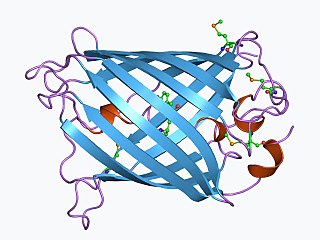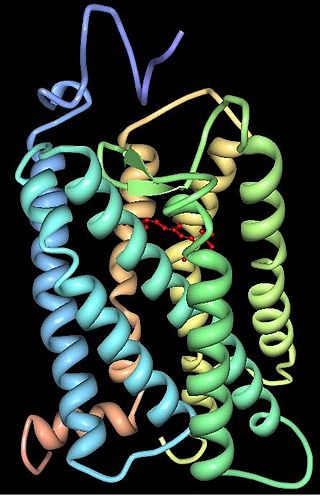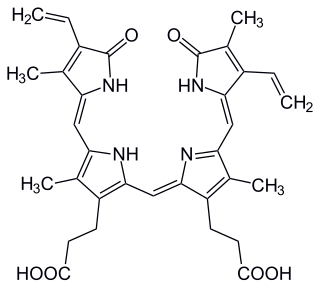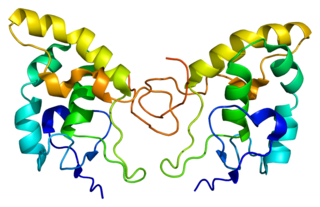Related Research Articles

The green fluorescent protein (GFP) is a protein that exhibits green fluorescence when exposed to light in the blue to ultraviolet range. The label GFP traditionally refers to the protein first isolated from the jellyfish Aequorea victoria and is sometimes called avGFP. However, GFPs have been found in other organisms including corals, sea anemones, zoanithids, copepods and lancelets.

Animal opsins are G-protein-coupled receptors and a group of proteins made light-sensitive via a chromophore, typically retinal. When bound to retinal, opsins become retinylidene proteins, but are usually still called opsins regardless. Most prominently, they are found in photoreceptor cells of the retina. Five classical groups of opsins are involved in vision, mediating the conversion of a photon of light into an electrochemical signal, the first step in the visual transduction cascade. Another opsin found in the mammalian retina, melanopsin, is involved in circadian rhythms and pupillary reflex but not in vision. Humans have in total nine opsins. Beside vision and light perception, opsins may also sense temperature, sound, or chemicals.

Biliverdin is a green tetrapyrrolic bile pigment, and is a product of heme catabolism. It is the pigment responsible for a greenish color sometimes seen in bruises.

Nomura's jellyfish is a very large rhizostome jellyfish, in the same size class as the lion's mane jellyfish, the largest cnidarian in the world. It is edible but not considered high quality. It is the only species in the monotypic genus Nemopilema. Commonly found in the waters of East Asia, and can negatively effect fisheries due to their large size and quantity. As a form of combating the large blooms, recent studies attempt to find new uses for the large jellyfish such as studying its venom for medical applications.

Biological pigments, also known simply as pigments or biochromes, are substances produced by living organisms that have a color resulting from selective color absorption. Biological pigments include plant pigments and flower pigments. Many biological structures, such as skin, eyes, feathers, fur and hair contain pigments such as melanin in specialized cells called chromatophores. In some species, pigments accrue over very long periods during an individual's lifespan.

Frizzled is a family of atypical G protein-coupled receptors that serve as receptors in the Wnt signaling pathway and other signaling pathways. When activated, Frizzled leads to activation of Dishevelled in the cytosol.

Animal colouration is the general appearance of an animal resulting from the reflection or emission of light from its surfaces. Some animals are brightly coloured, while others are hard to see. In some species, such as the peafowl, the male has strong patterns, conspicuous colours and is iridescent, while the female is far less visible.

Frizzled-2(Fz-2) is a protein that in humans is encoded by the FZD2 gene.

Frizzled-5(Fz-5) is a protein that in humans is encoded by the FZD5 gene.

Frizzled-3(Fz-3) is a protein that in humans is encoded by the FZD3 gene.

Frizzled-1(Fz-1) is a protein that in humans is encoded by the FZD1 gene.

Frizzled-6(Fz-6) is a protein that in humans is encoded by the FZD6 gene.

Frizzled-7(Fd-7) is a protein that in humans is encoded by the FZD7 gene.

Frizzled-8(Fz-8) is a protein that in humans is encoded by the FZD8 gene.

Frizzled-10(Fz-10) is a protein that in humans is encoded by the FZD10 gene. Fz-10 has also been designated as CD350.

Frizzled-4(Fz-4) is a protein that in humans is encoded by the FZD4 gene. Fz-4 has also been designated as CD344.

Pigment epithelium-derived factor (PEDF) also known as serpin F1 (SERPINF1), is a multifunctional secreted protein that has anti-angiogenic, anti-tumorigenic, and neurotrophic functions. Found in vertebrates, this 50 kDa protein is being researched as a therapeutic candidate for treatment of such conditions as choroidal neovascularization, heart disease, and cancer. In humans, pigment epithelium-derived factor is encoded by the SERPINF1 gene.

Secreted frizzled-related protein 1, also known as SFRP1, is a protein which in humans is encoded by the SFRP1 gene.

Secreted frizzled-related protein 4 is a protein that in humans is encoded by the SFRP4 gene.

Secreted frizzled-related protein 5 is a protein that in humans is encoded by the SFRP5 gene.
References
- 1 2 3 Lawley, Jonathan W.; Carroll, Anthony R.; McDougall, Carmel (2021-09-24). "Rhizostomins: A Novel Pigment Family From Rhizostome Jellyfish (Cnidaria, Scyphozoa)". Frontiers in Marine Science. 8: 752949. doi: 10.3389/fmars.2021.752949 . hdl: 10072/409365 . ISSN 2296-7745.
- ↑ Bulina, Maria E.; Lukyanov, Konstantin A.; Yampolsky, Ilia V.; Chudakov, Dmitry M.; Staroverov, Dmitry B.; Shcheglov, Alexander S.; Gurskaya, Nadya G.; Lukyanov, Sergey (October 2004). "New Class of Blue Animal Pigments Based on Frizzled and Kringle Protein Domains". Journal of Biological Chemistry. 279 (42): 43367–43370. doi: 10.1074/jbc.C400337200 . PMID 15297465.
- ↑ Blanquet, R. S.; Phelan, M. A. (1987-04-01). "An unusual blue mesogleal protein from the mangrove jellyfish Cassiopea xamachana". Marine Biology. 94 (3): 423–430. Bibcode:1987MarBi..94..423B. doi:10.1007/BF00428249. ISSN 1432-1793. S2CID 84985231.
- ↑ Santos, Marcela Colombo dos; Bicas, Juliano Lemos (March 2021). "Natural blue pigments and bikaverin". Microbiological Research. 244: 126653. doi: 10.1016/j.micres.2020.126653 . PMID 33302226. S2CID 228100424.